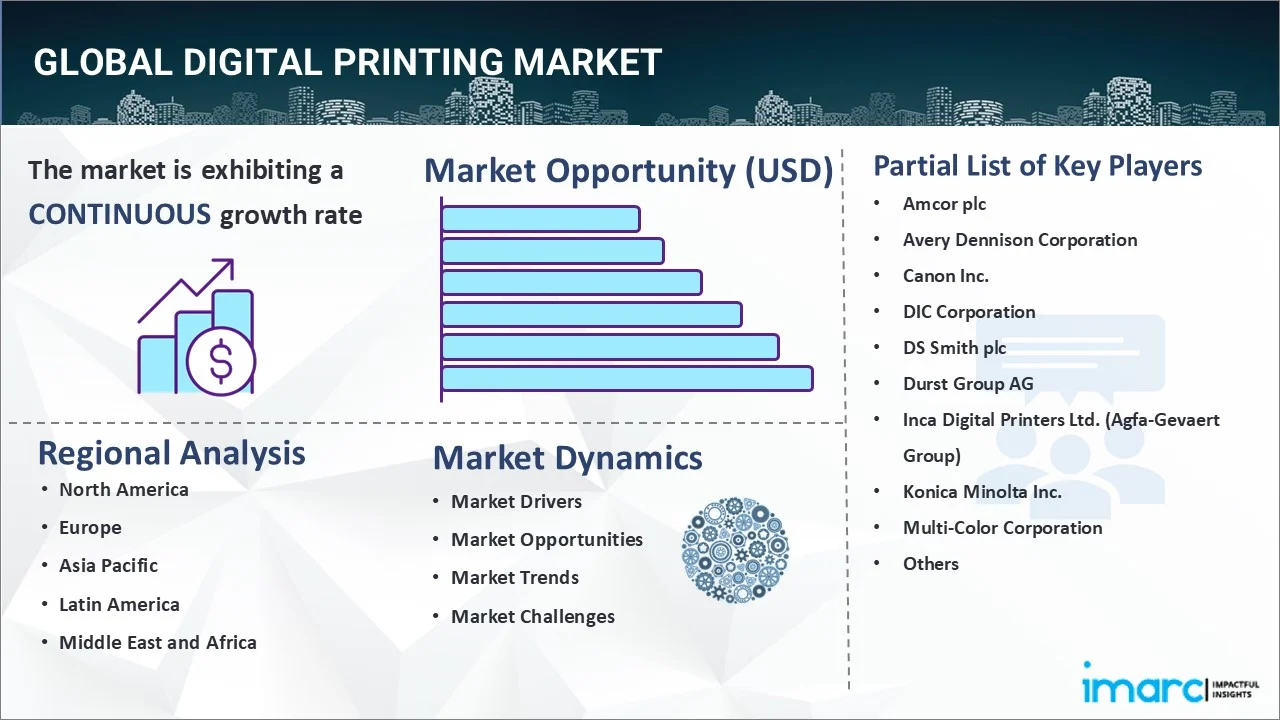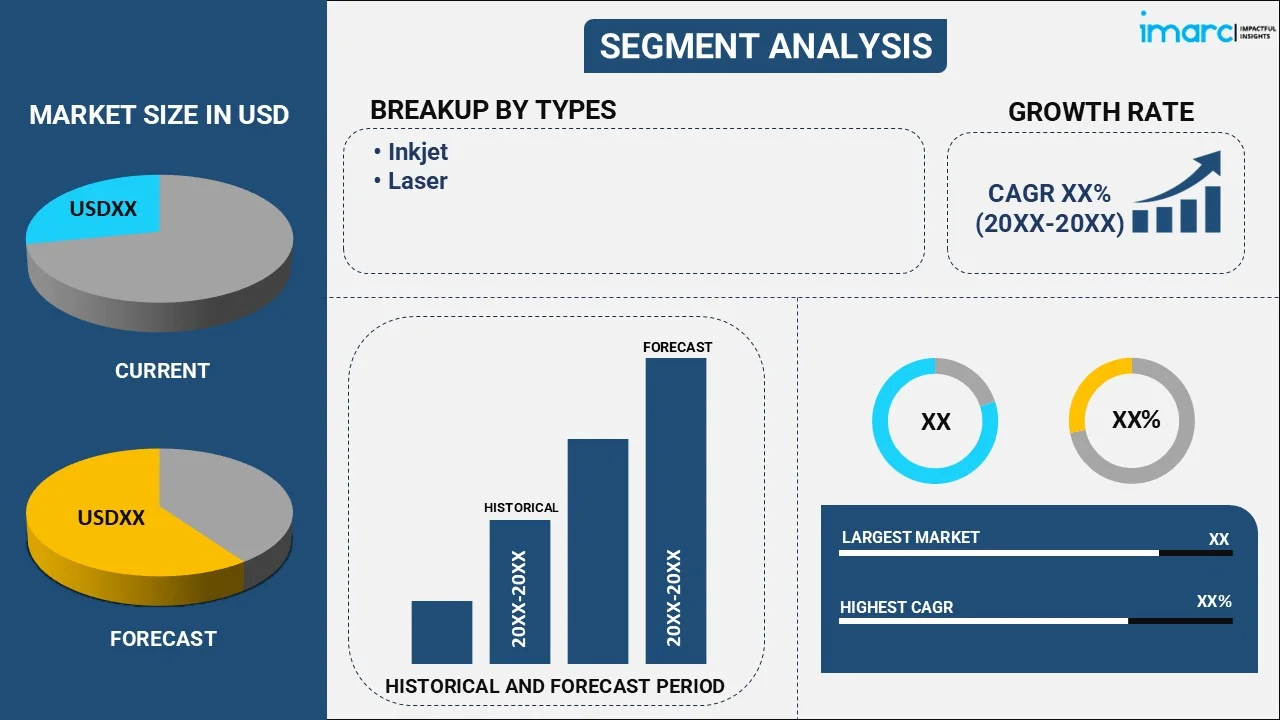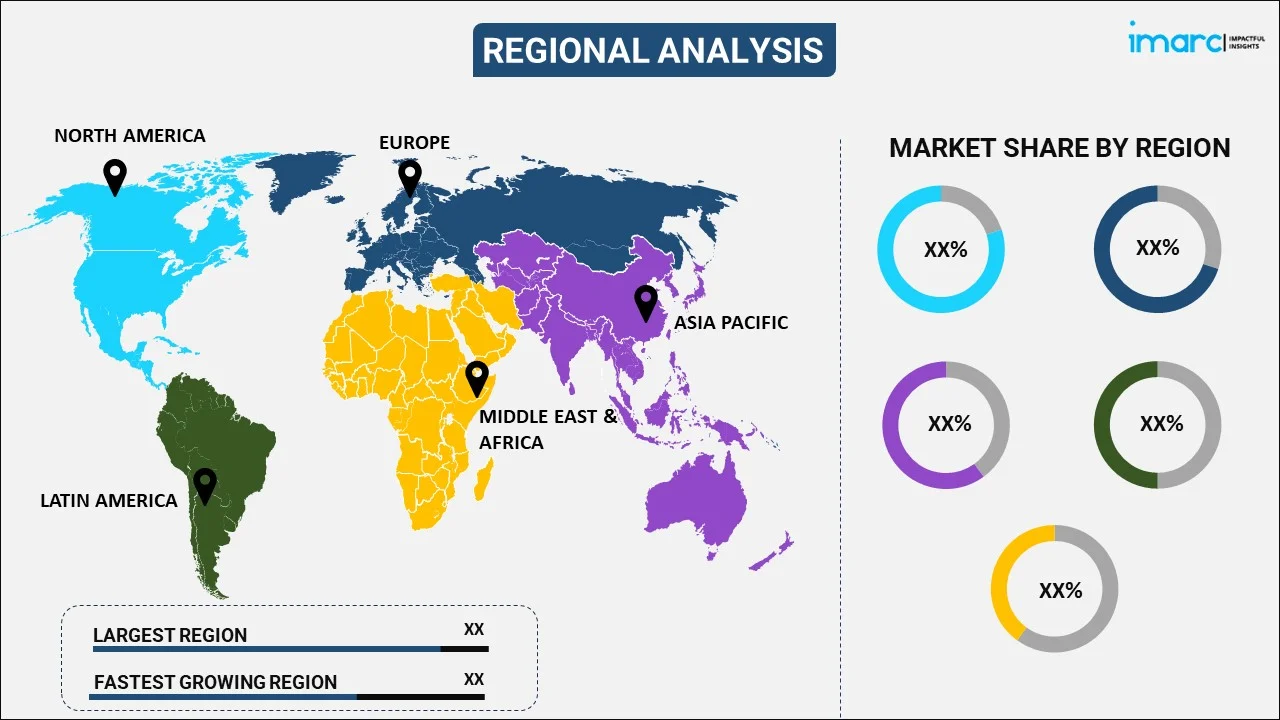
Digital Printing Market Report by Type (Inkjet, Laser), Ink Type (Aqueous Ink, UV-Cured Ink, Solvent Ink, Latex Ink, Dye Sublimation Ink), Application (Plastic Film or Foil, Fabric, Glass, Paper/Books, Ceramic, and Others), and Region 2025-2033
Market Overview:
The global digital printing market size reached USD 30.5 Billion in 2024. Looking forward, IMARC Group expects the market to reach USD 49.3 Billion by 2033, exhibiting a growth rate (CAGR) of 5.5% during 2025-2033. The increasing demand for personalized printing, technological advancements enhancing print quality, e-commerce's need for customizable packaging, and sustainability concerns favoring eco-friendly practices are some of the major factors propelling the market.
|
Report Attribute
|
Key Statistics
|
|---|---|
|
Base Year
|
2024
|
|
Forecast Years
|
2025-2033
|
|
Historical Years
|
2019-2024
|
| Market Size in 2024 | USD 30.5 Billion |
| Market Forecast in 2033 | USD 49.3 Billion |
| Market Growth Rate (2025-2033) | 5.5% |
Digital Printing Market Analysis:
- Major Market Drivers: The digital printing market revenue was moderate and is significantly expanding with the increasing technological advancements in digital solutions and the growing need for environmentally friendly printing options.
- Key Market Trends: The increasing commitment to green and eco-friendly printing is also driving an increase in digital printing demand because it generates less wasted supplies than traditional methods. Additionally, changes in end-user preferences are driving the rapid adoption of digital printing in packaging mainly because it enables customization and shorter production runs.
- Competitive Landscape: Some of the major market players in the global digital printing industry include Canon Inc, DIC Corporation, Seiko Epson Corporation, and Everlight Amcor PLC, among many others.
- Geographical Trends: North America exhibits a clear dominance in the market due to the early adoption of digital technologies and the strong presence of key industry players. Asia-Pacific is also emerging as a fast-growing market, driven by the rising demand for digital printing in the retail sector.
- Challenges and Opportunities: There are also a number of challenges, such as a significant initial cost investment and some technical complexities. However, the shift towards digital printing provides numerous opportunities, such as the opportunity to enter new markets through offering customized packaging and providing sustainable printing solutions due to the growing demand.

Digital Printing Market Trends/Drivers:
Demand for short-run and on-demand printing
The digital printing market products, including printers, inks, and software solutions is catering to the evolving needs of both commercial and individual users. The rising demand for short-run and on-demand printing across various sectors represents one of the key factors impelling the market growth. Concurrent with this, traditional printing methods often necessitate the creation of printing plates, which can be time-consuming and costly for small print quantities. Moreover, the U.S. Department of Commerce has issued a preliminary affirmative determination on countervailing duties for aluminum lithographic printing plates from China, effective March 1, 2024. The range of projected rates of countervailable subsidies is 38.50% to 231.98%.
Advancements in printing technology
The continuous innovations in digital methods, such as improved ink formulations, higher print resolutions, and enhanced color management are enhancing the print quality. Furthermore, the growing need for better visual output from a variety of industries, including the fashion and interior design sectors is positively influencing the market. Additionally, the remarkable clarity and color accuracy of digital printing in replicating complex designs makes it a flexible option for a range of applications, hence broadening its market reach. In addition, the Advances in Printing Technology 2022 conference highlighted cutting-edge advancements in printing technology, including innovative inkjet printing processes and sustainability initiatives. Organized by the Society for Imaging Sciences and Technology, the conference featured sessions on topics like digital printing technology, sustainable printing practices, and the environmental impact of printing.
Furthermore, the digital printing market value is projected to rise, driven by technological advancements and the growing demand for customized printing solutions across various sectors. In addition, Epson's inkjet printers, powered by heat-free technology, utilize up to 96% less energy compared to traditional laser printers.
E-commerce and packaging needs
The rising popularity of e-commerce platforms among the masses is driving the demand for effective and adaptable packaging solutions, opening opportunities for market growth. Besides this, the adaptability of digital printing to print on various substrates, combined with its capability to accommodate short print runs, aligns with the requirements of the e-commerce sector, catalyzing the digital printing market demand. Furthermore, different brands and merchants that are designing distinctive and visually appealing packaging for their products to improve their online visibility and customer appeal are bolstering the market growth. The new UNCTAD data revealed a notable increase in individual e-commerce activity in 2021, marked by a rise in online sales value across 66 surveyed countries. Before the observed period, online shopping had already gained traction, with an average of 53% of internet users making purchases online. This figure rose to 60% during the surveyed period. In addition, the digital printing market overview highlights its growth due to a shift towards sustainable printing solutions.
Digital Printing Industry Segmentation:
IMARC Group provides an analysis of the key trends in each segment of the global digital printing market report, along with forecasts at the global, regional, and country levels for 2025-2033. Our report has categorized the market based on type, ink type, and application.
Breakup by Type:

- Inkjet
- Laser
Inkjet dominates the market
The report has provided a detailed breakup and analysis of the market based on the type. This includes inkjet and laser. According to the report, inkjet represented the largest segment.
The growing demand for inkjet digital printing attributed to its versatility and applicability across diverse sectors is creating a favorable digital printing market outlook. The ability of this technique to print on a variety of substrates, such as ceramics, fabrics, and even three-dimensional objects, is drawing the attention of businesses looking for cutting-edge solutions. Additionally, inkjet printing is non-contact in nature and reduces the chance of substrate damage, which is suitable for sensitive materials. Moreover, Canon India announced the rebranding of its ink tank printer lineup to PIXMA MegaTank and MAXIFY MegaTank, showcasing advancements in inkjet printing technology. This move emphasized the commitment of the company to delivering high-quality printouts with best-in-class page yields at low costs, catering to the needs of modern users, including home offices and small businesses.
Apart from this, it provides vivid, high-resolution prints on unusual surfaces, including signs and packing, making it more appealing to businesses that prioritize visual appeal and brand distinction. These unique attributes position inkjet digital printing as a dynamic and adaptable choice. According to the data provided by IMARC Group, the printing packaging market reached US$ 22.6 billion in 2023 and is expected to acquire US$ 40.3 billion by 2032.
Breakup by Ink Type:
- Aqueous Ink
- UV-Cured Ink
- Solvent Ink
- Latex Ink
- Dye Sublimation Ink
Aqueous ink holds the largest share in the market
A detailed breakup and analysis of the market based on the ink type has also been provided in the report. This includes aqueous ink, UV-cured ink, solvent ink, latex ink, and dye sublimation ink. According to the report, aqueous ink accounted for the largest market share.
The demand for digital aqueous ink printing is mainly driven by its eco-friendly characteristics and suitability for various applications. As environmental concerns increasingly impact company activities, water-based, non-toxic aqueous inks are gaining popularity. Reducing their environmental impact is the top priority for these inks. Moreover, aqueous inks are recognized for producing prints with minimum emissions of volatile organic compounds (VOCs) and vivid and crisp images.
In addition, KRONOS was announced as a sponsor for the IMI Inkjet Conference 2022, where they unveiled their latest innovation: KRONOS 9900, a novel aqueous white pigment concentrate tailored for inkjet printing. This breakthrough addressed challenges in achieving successful white image printing, offering excellent stability, opacity, and whiteness. KRONOS 9900 was designed for water-based inkjet systems and complies with industry regulations.
Breakup by Application:
- Plastic Film or Foil
- Fabric
- Glass
- Paper/Books
- Ceramic
- Others
Plastic film or foil dominates the market
The report has provided a detailed breakup and analysis of the market based on the application. This includes plastic film or foil, fabric, glass, paper/books, ceramic, and others. According to the report, plastic film or foil represented the largest segment.
The increasing demand for digital printing on plastic film or foil owing to its ability to offer exceptional customization and cost-effective short-run production in the packaging industry is contributing to the digital printing market growth. Plastic film and foil are used in packaging due to their versatility, but traditional printing on these substrates often involves high setup costs and limited design flexibility. Digital printing solves these issues as it does not require printing plates and can produce complex and variable designs, making it ideal for smaller manufacturing quantities. This helps companies create striking, distinctive package designs that appeal to users, which is especially helpful for enterprises where packaging is a crucial marketing tool. In addition, digital printing on plastic film or foil is gaining traction due to the rising need for customized packaging and the need to stand out in a crowded market. Moreover, in March 2022, ProAmpac, a leading flexible packaging company, acquired Specialty Packaging, Inc., a family-owned manufacturer specializing in digital printing on plastic film and foil. This strategic move expanded ProAmpac’s reach in the food service industry and strengthened its position in digitally printed packaging.
Breakup by Region:

- North America
- United States
- Canada
- Asia-Pacific
- China
- Japan
- India
- South Korea
- Australia
- Indonesia
- Others
- Europe
- Germany
- France
- United Kingdom
- Italy
- Spain
- Russia
- Others
- Latin America
- Brazil
- Mexico
- Others
- Middle East and Africa
North America exhibits a clear dominance, accounting for the largest digital printing market share
The market research report has also provided a comprehensive analysis of all the major regional markets, which include North America (the United States and Canada); Asia Pacific (China, Japan, India, South Korea, Australia, Indonesia, and others); Europe (Germany, France, the United Kingdom, Italy, Spain, Russia, and others); Latin America (Brazil, Mexico, and others); and the Middle East and Africa. According to the report, North America accounted for the largest market share.
The thriving e-commerce industry in North America, propelled by a customer base with digital connectivity, is creating a need for customized and on-demand packaging solutions. The potential of digital printing to create short runs of personalized packaging with premium graphics fits with the trend of firms looking to improve their online presence. Moreover, the North American market has witnessed a surge in sustainability consciousness, with businesses and consumers alike showing a preference for eco-friendly practices. Additionally, the rising awareness about sustainability in the North American among both individuals and businesses is leading to a preference for eco-friendly methods. Apart from this, the focus of the region on innovation and technological advancement in digital printing technologies is ensuring that North America remains at the forefront of industry growth.
Competitive Landscape:
The competitive landscape of the global digital printing market is characterized by a dynamic interplay of established players and innovative newcomers, all vying for a significant market share. Key players dominate with their extensive product portfolios and well-established distribution networks, which allow them to serve a variety of sectors Moreover, emerging players are providing specialized products, which frequently target specialized markets with distinctive uses. The collaboration between print technology providers and software developers is resulting in workflow automation and enhanced print management systems, which provides clients with greater value. Additionally, the future of the digital printing market looks promising, with technological advancements and the growing demand for customization and eco-friendly solutions driving its expansion.
Fujifilm introduces AQUAFUZE inkjet ink technology, merging water-based and UV-curable inks for wide-format printing on plastic film and foil. This innovation, launching in Autumn 2024, offers stretchability, durability, and odorless printing, catering to indoor signage and wallpaper needs. It minimizes printhead clogging, adheres well without primers, reduces image thickness for a glossy finish, and prioritizes user safety.
The report has provided a comprehensive analysis of the competitive landscape in the market. Detailed profiles of all major companies have also been provided. Some of the key players in the market include:
- Amcor plc
- Avery Dennison Corporation
- Canon Inc.
- DIC Corporation
- DS Smith plc
- Durst Group AG
- Inca Digital Printers Ltd. (Agfa-Gevaert Group)
- Konica Minolta Inc.
- Multi-Color Corporation
- Ricoh Company Ltd.
- Seiko Epson Corporation
- Walsworth Publishing Company
- Xeikon B.V. (Flint Group)
- Xerox Corporation
(Please note that this is only a partial list of the key players, and the complete list is provided in the report.)
Recent Developments:
- In February 2022, Canon introduced an advanced, automated water-based polymer ink manufacturing facility in Venlo, designed to efficiently produce top-quality CMYK inks and meet the rising demand for inkjet production globally while reducing waste.
- In December 2021, Fujifilm Holdings Corporation introduced a new digital printing press, the Jet Press 750S High-Speed Model, featuring improved productivity and print quality.
- In March 2023, Glenroy® Inc., a leader in sustainable flexible packaging, has upgraded its operations with state-of-the-art flexographic plate mounting and demounting technology. The new Automatic SAMM 2.0 and Demounter improve efficiency, accuracy, and safety, reinforcing Glenroy's commitment to quality and customer satisfaction.
Digital Printing Market Report Scope:
| Report Features | Details |
|---|---|
| Base Year of the Analysis | 2024 |
| Historical Period | 2019-2024 |
| Forecast Period | 2025-2033 |
| Units | Billion USD |
| Scope of the Report | Exploration of Historical and Forecast Trends, Industry Catalysts and Challenges, Segment-Wise Historical and Predictive Market Assessment:
|
| Types Covered | Inkjet, Laser |
| Ink Types Covered | Aqueous Ink, UV-Cured Ink, Solvent Ink, Latex Ink, Dye Sublimation Ink |
| Applications Covered | Plastic Film or Foil, Fabric, Glass, Paper/Books, Ceramic, Others |
| Regions Covered | Asia Pacific, Europe, North America, Latin America, Middle East and Africa |
| Countries Covered | United States, Canada, Germany, France, United Kingdom, Italy, Spain, Russia, China, Japan, India, South Korea, Australia, Indonesia, Brazil, Mexico |
| Companies Covered | Amcor plc, Avery Dennison Corporation, Canon Inc., DIC Corporation, DS Smith plc, Durst Group AG, Inca Digital Printers Ltd. (Agfa-Gevaert Group), Konica Minolta Inc., Multi-Color Corporation, Ricoh Company Ltd., Seiko Epson Corporation, Walsworth Publishing Company, Xeikon B.V. (Flint Group), Xerox Corporation, etc. |
| Customization Scope | 10% Free Customization |
| Post-Sale Analyst Support | 10-12 Weeks |
| Delivery Format | PDF and Excel through Email (We can also provide the editable version of the report in PPT/Word format on special request) |
Key Benefits for Stakeholders:
- IMARC’s industry report offers a comprehensive quantitative analysis of various market segments, historical and current market trends, market forecasts, and dynamics of the digital printing market from 2019-2033.
- The research report provides the latest information on the market drivers, challenges, and opportunities in the global digital printing market.
- The study maps the leading, as well as the fastest-growing, regional markets. It further enables stakeholders to identify the key country-level markets within each region.
- Porter's five forces analysis assists stakeholders in assessing the impact of new entrants, competitive rivalry, supplier power, buyer power, and the threat of substitution. It helps stakeholders to analyze the level of competition within the digital printing industry and its attractiveness.
- Competitive landscape allows stakeholders to understand their competitive environment and provides an insight into the current positions of key players in the market.
Key Questions Answered in This Report
The global digital printing market was valued at USD 30.5 Billion in 2024.
We expect the global digital printing market to exhibit a CAGR of 5.5% during 2025-2033.
The rising consumer inclination towards digital printing over traditional analog printing processes, as it does not require printing plates and offers enhanced accuracy, flexibility, durability, and cost-effectiveness with minimal operational spaces, is primarily driving the global digital printing market.
The sudden outbreak of the COVID-19 pandemic had led to the implementation of stringent lockdown regulations across several nations, resulting in the temporary closure of various end-use industries for digital printing.
Based on the type, the global digital printing market can be segmented into inkjet and laser. Currently, inkjet holds the majority of the total market share.
Based on the ink type, the global digital printing market has been divided into aqueous ink, UV-cured ink, solvent ink, latex ink, and dye sublimation ink. Among these, aqueous ink currently exhibits a clear dominance in the market.
Based on the application, the global digital printing market can be categorized into plastic film or foil, fabric, glass, paper/books, ceramic, and others. Currently, plastic film or foil accounts for the largest market share.
On a regional level, the market has been classified into North America, Asia-Pacific, Europe, Latin America, and Middle East and Africa, where North America currently dominates the global market.
Some of the major players in the global digital printing market include Amcor plc, Avery Dennison Corporation, Canon Inc., DIC Corporation, DS Smith plc, Durst Group AG, Inca Digital Printers Ltd. (Agfa-Gevaert Group), Konica Minolta Inc., Multi-Color Corporation, Ricoh Company Ltd., Seiko Epson Corporation, Walsworth Publishing Company, Xeikon B.V. (Flint Group), and Xerox Corporation.
Need more help?
- Speak to our experienced analysts for insights on the current market scenarios.
- Include additional segments and countries to customize the report as per your requirement.
- Gain an unparalleled competitive advantage in your domain by understanding how to utilize the report and positively impacting your operations and revenue.
- For further assistance, please connect with our analysts.
 Inquire Before Buying
Inquire Before Buying
 Speak to an Analyst
Speak to an Analyst
 Request Brochure
Request Brochure
 Request Customization
Request Customization




.webp)




.webp)












